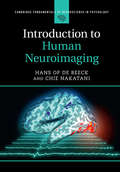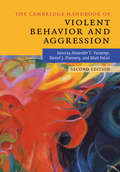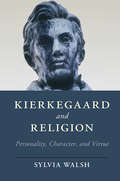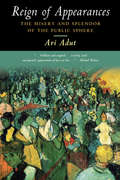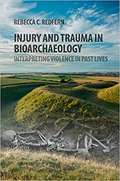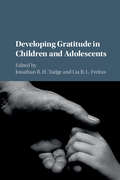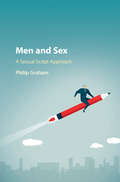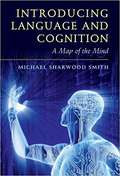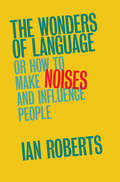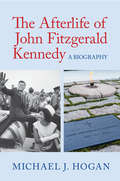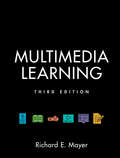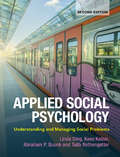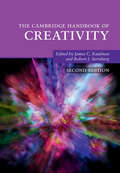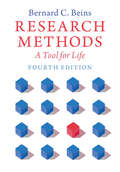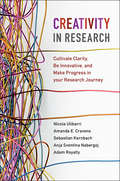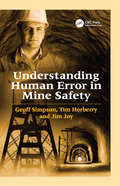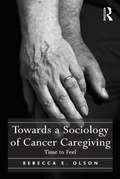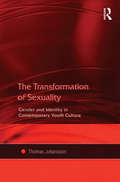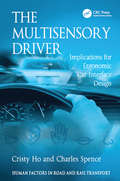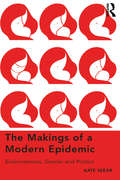- Table View
- List View
Introduction to Human Neuroimaging (Cambridge Fundamentals of Neuroscience in Psychology)
by Hans Op de Beeck Chie NakataniDeveloped specifically for students in the behavioral and brain sciences, this is the only textbook that provides an accessible and practical overview of the range of human neuroimaging techniques. Methods covered include functional and structural magnetic resonance imaging, positron emission tomography, electroencephalography, magnetoencephalography, multimodal imaging, and various brain stimulation methods. Experimental design, image processing, and statistical inference are also addressed, with chapters for both basic and more advanced data analyses. Key concepts are illustrated through research studies on the relationship between brain and behavior, and practice questions are included throughout to test knowledge and aid self-study. Offering just the right amount of detail for understanding how major imaging techniques can be applied to answer neuroscientific questions, and the practical skills needed for future research, this is an essential text for advanced undergraduate and graduate students in psychology, neuroscience, and cognitive science programs taking introductory courses on human neuroimaging.
The Cambridge Handbook of Violent Behavior and Aggression (Cambridge Handbooks in Psychology)
by Daniel J. Flannery Alexander T. Vazsonyi Matt DeLisiThe Cambridge Handbook of Violent Behavior and Aggression presents the current state of knowledge related to the study of violent behaviors and aggression. An important extension of the first Handbook published ten years ago, the second edition maintains a distinctly cross-disciplinary focus by representing the newest scholarship and insights from behavior genetics, cross-cultural comparative psychology/criminology, evolutionary psychology, criminal justice, criminology, human development, molecular genetics, neurosciences, psychology, prevention and intervention sciences, psychiatry, psychopharmacology, public health, and sociology. The Handbook is divided into introductory and overview chapters on the study of violent behavior and aggression, followed by chapters on biosocial bases, individual and interpersonal factors, contextual factors, and prevention and intervention work and policy implications. It is an essential resource for researchers, scholars, and graduate students across social and behavioral science disciplines interested in the etiology, intervention, and prevention of violent behavior and aggression.
Kierkegaard and Religion: Personality, Character, And Virtue (Cambridge Studies In Religion, Philosophy And Society )
by Sylvia WalshNo thinker has reflected more deeply on the role of religion in human life than Søren Kierkegaard, who produced in little more than a decade an astonishing number of works devoted to an analysis of the kind of personality, character, and spiritual qualities needed to become an authentic human being or self. <p><p>Understanding religion to consist essentially as an inward, passionate, personal relation to God or the eternal, Kierkegaard depicts the art of living religiously as a self through the creation of a kaleidoscope of poetic figures who exemplify the constituents of selfhood or the lack thereof. The present study seeks to bring Kierkegaard into conversation with contemporary empirical psychology and virtue ethics, highlighting spiritual dimensions of human existence in his thought that are inaccessible to empirical measurement, as well as challenging on religious grounds the claim that he is a virtue ethicist in continuity with the classical and medieval virtue tradition.<p> Explores and clarifies the concepts of personality, character, and virtue in Kierkegaard's thought.<p> Elucidates the dialectic of jest and earnestness, human agency and divine agency, human striving and grace in Kierkegaard's thought.<p> Relates Kierkegaard's concepts of personality, character, and virtue to alternative approaches in contemporary philosophy, theology, and empirical psychology.
Reign of Appearances: The Misery And Splendor Of The Public Sphere
by Ari AdutThe public sphere, be it the Greek agora or the New York Times op-ed page, is the realm of appearances - not citizenship. Its central event is spectacle - not dialogue. <P><P>Public dialogue, the mantra of many intellectuals and political commentators, is but a contradiction in terms. Marked by an asymmetry between the few who act and the many who watch, the public sphere can undermine liberal democracy, law, and morality. Inauthenticity, superficiality, and objectification are the very essence of the public sphere. But the public sphere also liberates us from the bondages of private life and fosters an existentially vital aesthetic experience. <P>Reign of Appearances uses a variety of cases to reveal the logic of the public sphere, including homosexuality in Victorian England, the 2008 crash, antisemitism in Europe, confidence in American presidents, communications in social media, special prosecutor investigations, the visibility of African-Americans, violence during the French Revolution, the Islamic veil, and contemporary sexual politics. <P>This unconventional account of the public sphere is critical reading for anyone who wants to understand the effects of visibility in urban life, politics, and the media.<P>Challenges the common wisdom that the public sphere is always good for democracy.<P> Asserts that spectatorship - and not civic participation - is the essence of the public sphere.<P> Argues that spectatorship, which is a much-disdained stance, is an existentially vital aesthetic experience.
Injury and Trauma in Bioarchaeology
by Rebecca C. RedfernThe remains of past people are a testament to their lived experiences and of the environment in which they lived. Synthesising the latest research, this book critically examines the sources of evidence used to understand and interpret violence in bioarchaeology, exploring the significant light such evidence can shed on past hierarchies, gender roles and life courses. The text draws on a diverse range of social and clinical science research to investigate violence and trauma in the archaeological record, focussing on human remains. It examines injury patterns in different groups as well as the biological, psychological and cultural factors that make us behave violently, how our living environment influences injury and violence, the models used to identify and interpret violence in the past, and how violence is used as a social tool. Drawing on a range of case studies, Redfern explores new research directions that will contribute to nuanced interpretations of past lives.
Developing Gratitude in Children and Adolescents
by Tudge Jonathan R. H. De Lucca Freitas Lia BeatrizIn popular opinion, gratitude means saying 'thank you'. While politeness and appreciation are certainly important, gratitude is a larger issue. Appropriately defined, it encompasses the strengthening of human relationships and qualifies as a moral virtue. This important and timely volume provides the conceptual framework for studying the development of gratitude, with a comprehensive and international set of authors approaching the topic from philosophical, psychological, and educational perspectives. The first section provides the theoretical underpinnings for the study of gratitude as a virtue. In the next section, the authors examine the ways in which gratitude develops, including key cross-cultural variations and some possible effects of its development. The final section then considers the links between parent and child gratitude and the ways in which parents and teachers can help to encourage gratitude, both in their everyday practices and by using literary texts.
The International African Library: After Rape
by Holly PorterFollowing the ICC intervention in 2005, northern Uganda has been at the heart of international justice debates. The emergent controversy, however, missed crucial aspects of Acholi realities: that the primary moral imperative in the wake of wrongdoing was not punishment but, instead, the restoration of social harmony. Drawing upon abundant fieldwork and in-depth interviews with almost 200 women, Holly Porter examines issues surrounding wrongdoing and justice, and sexual violence and rape, among the Acholi people in northern Uganda. This intricate exploration offers evidence of a more complicated and nuanced explanation of rape and its aftermath, suggesting a re-imagining of the meanings of post-atrocity justice, whilst acknowledging the role of sex, power and politics in all sexual experiences between coercion and consent. With its wide investigation of social life in northern Uganda, this provocative study offers vital analysis for those interested in sexual and gender violence, post-conflict reconstruction and human rights.
Men and Sex: A Sexual Script Approach
by Philip GrahamMen and Sex provides a comprehensive yet accessible account of male sexuality by using the theoretical concept of the 'sexual script' to illuminate different aspects of men's sexual behaviour. Graham begins by discussing different theories of sexuality, before providing a more detailed description of sexual script theory. This proposes how male sexual behaviour can be explained as a result of cultural influences modified by individual experience and personality as well as by interaction with others. Individual chapters detail the development of sexual scripts in childhood and adolescence, masturbation, cultural influences on sexuality, heterosexual behaviour, variations and problems in sexual functioning, homosexual behaviour, transsexualism, procreative sex, coercive sexual behaviour, the impact of physical and mental health problems on sexuality, and sexuality and pornography. The concluding chapter looks at the future of male sexuality. The book makes a valuable contribution to the burgeoning literature on masculinity studies.
The Cambridge Handbook of the Psychology of Prejudice
by Barlow Sibley Chris G. Fiona KateThe Cambridge Handbook of the Psychology of Prejudice aims to answer the questions: why is prejudice so persistent? How does it affect people exposed to it? And what can we do about it? Providing a comprehensive examination of prejudice from its evolutionary beginnings and environmental influences through to its manifestations and consequences, this handbook is an essential resource for scholars and students who are passionate about understanding prejudice, social change, collective action, and prejudice reduction. Featuring cutting-edge research from top scholars in the field, the chapters provide an overview of psychological models of prejudice; investigate prejudice in specific domains such as race, religion, gender, and appearance; and develop explicit, evidence-based strategies for disrupting the processes that produce and maintain prejudice. This handbook challenges researchers and readers to move beyond their comfort zone, and sets the agenda for future avenues of research, policy, and intervention.
Introducing Language and Cognition
by Smith Michael SharwoodIn this accessible introduction, Mike Sharwood Smith provides a working model or 'map' of the mind, with language as its centrepiece. Drawing on cutting-edge research across linguistics, psychology and neuroscience, it allows students to quickly grasp how each separate aspect of the mind's operations can be related. This 'big picture' view includes the way the mind makes, stores and loses memories of all kinds as well how its various 'expert systems' combine and collaborate to solve, typically beyond our conscious awareness, the myriad of tasks we are faced with every minute and millisecond of our existence. The book also focuses on language, that is, the mind of monolingual, bilingual and multilingual speakers. It will be of interest to all students wishing to learn more about the complex relationship between language - one of the most important ways in which we define ourselves as human - and the mind.
Substance and Behavioral Addictions
by Steve SussmanSubstance and Behavioral Addictions: Concepts, Causes, and Cures presents the concepts, etiology, assessment, prevention, and cessation of substance (tobacco, alcohol, other drugs, and food) and behavioral (gambling, Internet, shopping, love, sex, exercise, and work) addictions. The text provides a novel and integrative appetitive motivation framework of addiction, while acknowledging and referencing multi-level influences on addiction, such as neurobiological, cognitive, and micro-social and macro-social/physical environmental. The book discusses concurrent and substitute addiction, and offers prevention and treatment solutions, which are presented from a more integrative perspective than traditional presentations. This is an ideal text for upper-level undergraduates and graduate students, practitioners, and researchers.
The Age of Charisma
by Young Jeremy C.An innovative examination of American society, culture, and politics, The Age of Charisma argues that the modern relationship between American leaders and followers grew out of a unique group of charismatic social movements prominent in the late-nineteenth and early-twentieth centuries. Drawing on hundreds of letters and testimonials, Jeremy C. Young illustrates how 'personal magnetism' in public speaking shaped society by enabling a shift from emotionally-inaccessible leadership to emotionally-available leadership. This charismatic speaking style caused a rapid transformation in the leader-follower relationship, creating an emotional link between speakers and listeners, and the effects of this social transformation remain with us today. Young argues that ultimately, charismatic movements enhanced American democracy by encouraging the personalization of leadership - creating a culture in which today's leaders appeal directly to Americans through mass media.
Cambridge Studies in Law and Society: Buried in the Heart
by Erin BainesIn Buried in the Heart, Erin Baines explores the political agency of women abducted as children by the Lord's Resistance Army in northern Uganda, forced to marry its commanders, and to bear their children. Introducing the concept of complex victimhood, she argues that abducted women were not passive victims, but navigated complex social and political worlds that were life inside the violent armed group. Exploring the life stories of thirty women, Baines considers the possibilities of storytelling to reclaim one's sense of self and relations to others, and to generate political judgement after mass violence. Buried in the Heart moves beyond victim and perpetrator frameworks prevalent in the field of transitional justice, shifting the attention to stories of living through mass violence and the possibilities of remaking communities after it. The book contributes to an overlooked aspect of international justice: women's political agency during wartime.
The Wonders of Language
by Ian RobertsIan Roberts offers a stimulating introduction to our greatest gift as a species: our capacity for articulate language. We are mostly as blissfully unaware of the intricacies of the structure of language as fish are of the water they swim in. We live in a mental ocean of nouns, verbs, quantifiers, morphemes, vowels and other rich, strange and deeply fascinating linguistic objects. This book introduces the reader to this amazing world. Offering a thought-provoking and accessible introduction to the main discoveries and theories about language, the book is aimed at general readers and undergraduates who are curious about linguistics and language. Written in a lively and direct style, technical terms are carefully introduced and explained and the book includes a full glossary. The book covers all the central areas of linguistics, including phonetics, phonology, morphology, syntax, semantics and pragmatics, as well as historical linguistics, sociolinguistics and psycholinguistics.
The Afterlife of John Fitzgerald Kennedy
by Michael J. HoganIn his new book, Michael J. Hogan, a leading historian of the American presidency, offers a new perspective on John Fitzgerald Kennedy, as seen not from his life and times but from his afterlife in American memory. The Afterlife of John Fitzgerald Kennedy considers how Kennedy constructed a popular image of himself, in effect, a brand, as he played the part of president on the White House stage. The cultural trauma brought on by his assassination further burnished that image and began the process of transporting Kennedy from history to memory. Hogan shows how Jacqueline Kennedy, as the chief guardian of her husband's memory, devoted herself to embedding the image of the slain president in the collective memory of the nation, evident in the many physical and literary monuments dedicated to his memory. Regardless of critics, most Americans continue to see Kennedy as his wife wanted him remembered: the charming war hero, the loving husband and father, and the peacemaker and progressive leader who inspired confidence and hope in the American people.
Multimedia Learning (Cambridge Handbooks In Psychology Ser.)
by Richard MayerAdvances in computer graphic technologies have inspired new efforts to understand the potential of multimedia instruction as a means of promoting human learning. In Multimedia Learning, Third Edition, Richard E. Mayer takes an evidence-based approach to improving education using well-designed multimedia instruction. He reviews 15 principles of multimedia instructional design that are based on more than 200 experimental research studies and grounded in a cognitive theory of how people learn from words and graphics. The result is the latest instalment of what Mayer calls the Cognitive Theory of Multimedia Learning, a theory introduced in previous editions of Multimedia Learning and in The Cambridge Handbook of Multimedia Learning, Second Edition. This edition provides an up-to-date and systematic summary of research studies on multimedia learning, supplemented with complementary evidence from around the globe. It is well-suited to graduate and undergraduate courses in psychology, education, computer science, communication, instructional design, and game design.
Applied Social Psychology
by Linda Steg Talib Rothengatter Kees Keizer Buunk Abraham P.`I think this is a wonderful book. The social psychological theories are exceptionally well presented for practical use. Anyone studying social psychology will find this book extremely relevant and accessible' - Gerjo Kok, Professor of Applied Psychology, Department of Work and Social Psychology, Maastricht University `This is a highly readable book dealing with an exciting topic, applied social psychology, which is at the heart of many urgent problems of the new millennium. It is well suited for curing the disease of those who still believe there is an opposition between fundamental and applied research, between theories and practice. The major asset of this volume lies in the originality and strength of the PATH concept -- from problem definition, over analysis, and test, to helping. I like the idea to implement and institutionalize this framework in teaching and in education' - Klaus Fiedler, University of Heidelberg Introducing a new methodological approach for doing applied psychology, the PATH model, this book offers a simple, systematic, step-by-step, easy-to-use methodology for applying primarily social psychological theory to a wide range of social problems, from tackling crime and prejudice to fostering environmental conservation and team performance. It helps and guides students to define a problem, conduct a theory-based analysis, develop an explanatory model, set up and execute a research project to test the model, and develop an intervention. Applying Social Psychology is a highly practical text, which can be used by introductory and advanced level students who want to learn how to analyze practical problems and develop solutions for these problems based upon social psychological theory and research. Written in an engaging and accessible way, this book offers: 1. A new methodological model put forward by the authors (PATH model); 2. Real world case studies; 3. End of chapter exercises; 4. Interviews with leading social psychologists; 5. Glossary of key theories and concepts in social psychology; 6. Recommended further reading.
The Cambridge Handbook of Creativity (Cambridge Handbooks in Psychology)
by Robert J. Sternberg James C. KaufmanThis second edition of the renowned Cambridge Handbook of Creativity expands on the first edition with over two thirds new material reaching across psychology, business, entrepreneurship, education, and neuroscience. It introduces creativity scholarship by summarising its history, major theories and assessments, how creativity develops across the lifespan, and suggestions for improving creativity. It also illustrates cutting-edge work on genetics and the neuroscience of creativity, alongside creativity's potential for both benevolence and malevolence. The chapters cover the related areas of imagination, genius, play, and aesthetics and tackle questions about how cultural differences, one's physical environment, mood, and self-belief can impact creativity. The book then examines the impacts on creativity of behaviour by teachers, managers, and leaders in particular.
Research Methods: A Tool for Life
by Bernard C. BeinsResearch Methods is an introduction to the importance of scientific research in everyday life and uses familiar examples to keep students engaged. The text analyzes controversies in psychology to stimulate student interest while explaining crucial methodological concepts. It presents ethical issues related to research, as well as social and cultural factors that might affect it, and provides a comprehensive introduction to a wide variety of methodologies. Through this book, students will learn how to generate research questions and select appropriate methodology, as well as to write a successful research report.
Creativity in Research: Cultivate Clarity, Be Innovative, and Make Progress in your Research Journey
by Nicola Ulibarri Amanda E. Cravens Anja Svetina Nabergoj Sebastian Kernbach Adam RoyaltyCreativity is at the heart of successful research, yet researchers are rarely taught how to manage their creative process, and modern academic life is not structured to optimize creativity. Creativity in Research provides concrete guidance on developing creativity for anyone doing or mentoring research. Based on a curriculum developed at Stanford University's Hasso Plattner Institute of Design, this book presents key abilities that underlie creative research practice through a combination of scientific literature on creative confidence, experiential exercises, and guided reflection. By focusing attention on how research happens as well as its outputs, researchers increase their ability to address research challenges and produce the outputs they care about. Simultaneously, they may also transform their emotional relationship with their work, replacing stress and a harsh inner critic with a more open and emotionally empowered attitude.
Understanding Human Error in Mine Safety
by Tim Horberry Geoff SimpsonThe consideration of human factors issues is vital to the mining industry. As in other safety-critical domains, human performance problems constitute a significant threat to system safety, making the study of human factors an important field for improving safety in mining operations. The primary purpose of this book is to provide the reader with a much-needed overview of human factors within the mining industry, in particular to understand the role of human error in mine safety, explaining contemporary risk management and safety systems approaches. The approach taken is multidisciplinary and holistic, based on a model of the systems of work in the mining industry domain. The ingredients in this model include individual operators, groups/teams, technology/equipment, work organisation and the physical environment. Throughout the book, topics such as human error and safety management are covered through the use of real examples and case studies, allowing the reader to see the practical significance of the material presented while making the text rigorous, useful and enjoyable. Understanding Human Error in Mine Safety is written for professionals in the field, researchers and students of mining engineering, safety or human factors.
Towards a Sociology of Cancer Caregiving: Time to Feel
by Rebecca E. OlsonOnce a synonym for death, cancer is now a prognosis of multiple probabilities and produces a world of uncertainty for carers. Drawing on rich, in-depth interview data and employing interactionist theories, Towards a Sociology of Cancer Caregiving explores carers' lived experiences, paying close attention to the ways in which spouse carers manage the ambiguity that pervades their orientations to the future, their responsibilities and their emotions. A detailed exploration of the temporal and emotional journeys of spouse carers of cancer patients, this volume raises and responds to new questions about how to conceptualise informal caregiving, offering a fresh theorisation of the uncertainty that now characterises cancer. As such, it will appeal to scholars of the sociologies of emotion, time and identity, and all those interested in the question of how to support informal carers.
The Transformation of Sexuality: Gender and Identity in Contemporary Youth Culture
by Thomas JohanssonHow do contemporary young people construct their sexual identities? Are young people sexually liberated, or is human sexuality increasingly controlled and manipulated by commercial forces? Thomas Johansson explores the construction of sexual identities by young people as part of a wider process of identity construction, combining the work of key authors such as Elias and Foucault with original and revealing empirical material drawn from an extensive survey of the views of 1300 sixteen to nineteen year olds, combined with a number of qualitative in-depth interviews with different sexual subcultures. Topics covered include fidelity and infidelity, love, homosexuality, pornography and beauty ideals. Designed to look beyond media images and popular prejudices the book illustrates how young people of both genders, of different nationalities and of different group allegiances view and relate to their own sexuality.
The Multisensory Driver: Implications for Ergonomic Car Interface Design (Human Factors in Road and Rail Transport)
by Charles Spence Cristy HoDriver inattention has been identified as one of the leading causes for car accidents. The problem of distraction while driving is likely to worsen, partly due to increasingly complex in-car technologies. However, intelligent transport systems are being developed to assist drivers and to ensure a safe road environment. One approach to the design of ergonomic automobile systems is to integrate our understanding of the human information processing systems into the design process. This book aims to further the design of ergonomic multisensory interfaces using research from the fast-growing field of cognitive neuroscience. It focuses on two aspects of driver information-processing in particular: multisensory interactions and the spatial distribution of attention in driving. The Multisensory Driver provides interface design guidelines together with a detailed review of current cognitive neuroscience and behavioural research in multisensory human perception, which will help the development of ergonomic interfaces. The discussion on spatial attention is particularly relevant for car interface designers, but it will also appeal to cognitive psychologists interested in spatial attention and the applications of these theoretical research findings. Giving a detailed description of a cohesive series of psychophysical experiments on multisensory warning signals, conducted in both laboratory and simulator settings, this book provides an approach for those in the engineering discipline who wish to test their systems with human observers.
The Makings of a Modern Epidemic: Endometriosis, Gender and Politics
by Kate SeearSince its ’discovery’ some 150 years ago, thinking about endometriosis has changed. With current estimates identifying it as more common than breast and ovarian cancer, this chronic, incurable gynaecological condition has emerged as a ’modern epidemic’, distinctive in being perhaps the only global epidemic peculiar to women. This timely book addresses the scholarly neglect of endometriosis by the social sciences, offering a critical assessment of one of the world’s most common - and burdensome - health problems for women. Drawing on a range of theoretical perspectives, including science and technology studies, feminist theory and queer theory, The Makings of a Modern Epidemic explores the symbolic, discursive and material dimensions of the condition. It demonstrates how shifts in thinking about gender, the body, race, modernity and philosophies of health have shaped the epidemic, and produces a compelling account of endometriosis as a highly politicised and grossly neglected disease. Drawing upon rich empirical data, including in-depth interviews with women who have endometriosis and medical and self-help literature, this ground-breaking volume will appeal to scholars and students across the social sciences with interests in gender studies, science and technology studies and the sociology and anthropology of medicine, health and the body.
